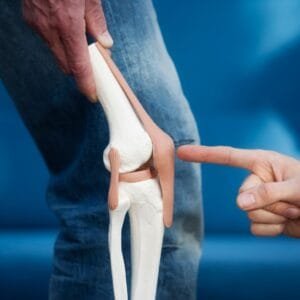Osteoarthritis: Causes, Symptoms, and Treatment
Osteoarthritis (OA) is a common degenerative joint disease that occurs when the protective cartilage cushioning the ends of bones wears down over time. It is the most prevalent form of arthritis, often referred to as a “wear-and-tear” condition, affecting millions of people worldwide. Although osteoarthritis can’t be cured, various treatments and lifestyle adjustments can help manage symptoms and improve quality of life.



What is Osteoarthritis?
Osteoarthritis is a chronic condition that primarily affects the joints, leading to pain, stiffness, and reduced mobility. It commonly affects weight-bearing joints such as the knees, hips, and spine but can also occur in the hands, fingers, and shoulders.
The disease progresses as cartilage, the smooth tissue that enables joints to move easily, breaks down. This leads to friction between bones, causing pain, swelling, and eventual joint damage.
Causes of Osteoarthritis
Osteoarthritis is caused by a combination of factors that increase stress on the joints. These include:
1. Aging
- The risk of osteoarthritis increases with age as joint tissues naturally degenerate.
2. Joint Injury or Overuse
- Repeated stress from injuries or repetitive motions accelerates cartilage wear.
3. Obesity
- Excess body weight places added pressure on weight-bearing joints like the knees and hips.
4. Genetics
- A family history of osteoarthritis increases the likelihood of developing the condition.
5. Other Medical Conditions
- Conditions such as rheumatoid arthritis, gout, or metabolic disorders may increase the risk.
Symptoms of Osteoarthritis
The symptoms of osteoarthritis can range from mild discomfort to debilitating pain. Common signs include:
Early Symptoms
- Joint Pain: Often worsens with activity and eases with rest.
- Stiffness: Especially noticeable after periods of inactivity, like waking up in the morning.
Progressive Symptoms
- Swelling: Due to inflammation or fluid buildup in the joint.
- Decreased Range of Motion: Difficulty in moving the affected joint fully.
- Grinding Sensation: A grating or clicking sound when moving the joint.
Advanced Symptoms
- Joint Deformity: Visible changes in joint structure in severe cases.
- Chronic Pain: Persistent discomfort that interferes with daily activities.
Diagnosis of Osteoarthritis
Diagnosing osteoarthritis involves a combination of physical evaluation, medical history, and imaging tests:
- Physical Examination:
- Assessment of joint tenderness, swelling, and range of motion.
- X-rays:
- Identify joint space narrowing, bone spurs, or cartilage loss.
- MRI:
- Provides detailed images of cartilage and other soft tissues for a more precise diagnosis.
- Blood Tests:
- Rule out other conditions like rheumatoid arthritis or gout.
- Joint Fluid Analysis:
- Checks for inflammation or crystals in the joint fluid.
Treatment Options for Osteoarthritis
While osteoarthritis cannot be reversed, treatments aim to alleviate symptoms, improve joint function, and slow disease progression. Options include:
Medications
- Pain Relievers:
- Over-the-counter drugs like acetaminophen or ibuprofen for mild pain.
- Nonsteroidal Anti-Inflammatory Drugs (NSAIDs):
- Reduce inflammation and relieve moderate to severe pain (e.g., naproxen, diclofenac).
- Topical Treatments:
- Creams or gels containing capsaicin or NSAIDs applied directly to the joint.
- Corticosteroid Injections:
- Provide temporary relief from inflammation and pain.
- Hyaluronic Acid Injections:
- Lubricates the joint and improves mobility.
Physical Therapy and Lifestyle Changes
- Physical Therapy:
- Tailored exercises to strengthen muscles and improve joint flexibility.
- Weight Management:
- Reduces stress on weight-bearing joints.
- Assistive Devices:
- Braces, orthotics, or canes to relieve joint stress.
- Exercise:
- Low-impact activities like swimming, cycling, or yoga to improve joint function.
Surgical Treatments
- Arthroscopy:
- Minimally invasive surgery to clean out damaged cartilage or bone fragments.
- Osteotomy:
- Reshapes bones to reduce joint stress.
- Joint Replacement Surgery:
- Replaces damaged joints with artificial implants, commonly for knees or hips.
Managing Osteoarthritis at Home
Self-care strategies play a vital role in managing osteoarthritis symptoms:
- Hot and Cold Therapy:
- Heat relieves stiffness, while cold reduces swelling and pain.
- Stay Active:
- Regular movement prevents stiffness and strengthens muscles around the joint.
- Balanced Diet:
- Include anti-inflammatory foods rich in omega-3 fatty acids, vitamins, and antioxidants.
- Ergonomic Adjustments:
- Use supportive chairs, proper footwear, and tools to reduce joint strain.
Complications of Osteoarthritis
Without proper management, osteoarthritis can lead to complications such as:
- Chronic Pain:
- Persistent pain may limit daily activities and reduce quality of life.
- Loss of Mobility:
- Severe joint damage may require assistive devices or surgery.
- Emotional Impact:
- Chronic conditions can lead to anxiety or depression.
Preventing Osteoarthritis
While some risk factors like aging or genetics cannot be controlled, certain measures can reduce the risk of developing osteoarthritis:
- Maintain a Healthy Weight:
- Prevents excess strain on joints.
- Stay Active:
- Regular exercise strengthens muscles and supports joint stability.
- Protect Joints:
- Use proper techniques when lifting or exercising to avoid injuries.
- Eat a Nutrient-Rich Diet:
- Foods high in calcium and vitamin D promote bone health.
FAQs about Osteoarthritis
1. What is osteoarthritis?
Osteoarthritis is a degenerative joint disease that occurs when cartilage breaks down, causing pain, stiffness, and reduced mobility.
2. What are the early signs of osteoarthritis?
Early symptoms include joint pain, stiffness after inactivity, and mild swelling around the affected joint.
3. Can osteoarthritis be cured?
There is no cure for osteoarthritis, but treatments can manage symptoms and improve quality of life.
4. What exercises are good for osteoarthritis?
Low-impact activities like swimming, walking, and yoga help strengthen muscles without overloading joints.
5. When should I see a doctor for osteoarthritis?
Consult a doctor if you experience persistent joint pain, stiffness, or difficulty performing daily activities.
Conclusion
Osteoarthritis is a progressive condition that affects millions worldwide, but it doesn’t have to dominate your life. By combining medical treatments, physical therapy, and lifestyle adjustments, individuals can effectively manage symptoms and maintain an active, fulfilling lifestyle. If you suspect osteoarthritis, seek medical advice for a tailored treatment plan to protect your joint health.
